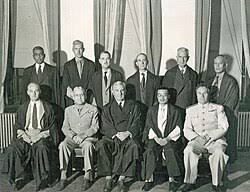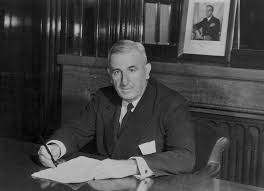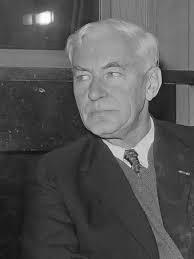The Tribunal and Its Origins
The International Military Tribunal for the Far East (IMTFE)—better known as the Tokyo Trials—was convened on 29 April 1946 by Supreme Allied Commander General Douglas MacArthur to prosecute Japanese wartime leaders. It was modelled directly on the Nuremberg Trials in Europe, adopting the same three categories of crimes: Class A (crimes against peace), Class B (war crimes), and Class C (crimes against humanity).

Nuremberg had concluded its main trial in October 1946; Tokyo extended its legal principles to the Asia–Pacific theatre. Where Nuremberg dealt with Nazi Germany, the IMTFE addressed the vast Japanese-led war in Asia and the Pacific.
The Tribunal lasted until 12 November 1948, spanning 818 days of hearings, calling 419 witnesses, and producing nearly 50,000 pages of transcripts. Eleven judges, appointed by MacArthur, represented the Allied nations:
- Sir William Flood Webb (Australia – President)
- Edward Stuart McDougall (Canada)
- Mei Ju-ao (China)
- Henri Bernard (France)
- Radhabinod Pal (India)
- Bert Röling (Netherlands)
- Erima Harvey Northcroft (New Zealand)
- John Patrick Higgins (Philippines)
- Ivan Michyevich Zaryanov (Soviet Union)
- Lord William Patrick (United Kingdom)
- Myron Cramer (United States)
While judges like Pal of India and Mei of China left powerful dissents, for the purposes of this Dutch Australian Cultural Centre article we focus on the two judges most directly connected to our heritage story: Sir William Flood Webb of Australia and Bert Röling of the Netherlands.
Sir William Flood Webb – Australia’s Decisive Role
Sir William Webb was one of Australia’s most eminent jurists, serving as Chief Justice of Queensland and later as a Justice of the High Court. During the war, he produced the “Webb Reports” (1943–45) documenting Japanese atrocities in New Guinea and elsewhere—evidence later used in prosecutions.
MacArthur appointed Webb as President of the IMTFE, giving Australia the most prominent position in the Tribunal. Webb presided over all sessions, guided complex evidentiary rulings, and maintained order among a bench often divided on legal and political grounds. On 12 November 1948, he delivered the verdicts: seven death sentences, sixteen life imprisonments, and other fixed terms.
Webb’s leadership gave Australia unprecedented visibility in post-war international justice. As the only non–UN Security Council nation to head one of the two major war crimes tribunals, Australia demonstrated it could lead in both legal and geopolitical arenas.
Bert Röling – A Dutch Voice of Dissent
Bernard Victor Aloysius “Bert” Röling, a Dutch law professor, represented the Netherlands—a nation directly scarred by the Japanese occupation of the Netherlands East Indies.
Röling accepted the Tribunal’s legitimacy but dissented on several issues:
- Aggressive war charges lacked a clear legal basis at the time and risked retroactive justice.
- Punishments should reflect actual power and responsibility rather than position alone.
- The Tribunal undermined impartiality by shielding Allied actions from scrutiny.
Unlike India’s Judge Pal, who would have acquitted all defendants, Röling offered a more restrained dissent—supporting convictions for conventional war crimes but questioning the extension of new principles. His dissent became an enduring touchstone in debates over the legitimacy of international criminal law.
MacArthur’s Control and Its Consequences
Unlike Nuremberg, which was jointly run by four powers, the Tokyo Tribunal was entirely under MacArthur’s authority as Supreme Commander. He created it by charter, appointed all judges and prosecutors, and retained the power to shape its scope. This control had lasting effects:
- Emperor Hirohito and the imperial family were excluded from prosecution.
- Japanese officials, including scientists from Unit 731, received immunity in exchange for intelligence.
- The Tribunal’s existence itself was contingent on MacArthur’s will, exposing its political fragility.
The Under-Recognition of Asian Victims
The greatest share of victims in the Asia–Pacific war were Asian civilians. In China alone, an estimated 15 to 20 million people died during the war with Japan. Across Asia as a whole—including China, Southeast Asia, Korea, and the Pacific—the civilian toll is placed between 20 and 30 million.
In the Netherlands East Indies, still a Dutch colony at the time, between 3 and 4 million Indonesians died of famine, forced labour, and disease under Japanese occupation, alongside some 30,000 European internees who perished in camps. Although Indonesians were not Dutch nationals, they were subjects of the Dutch colonial realm, and their deaths form part of the wider tragedy of Dutch wartime losses in Asia.
For comparison, Europe’s civilian and military losses during WWII are estimated at around 35 to 40 million, including the Holocaust and the Soviet Union’s enormous wartime casualties. Australia’s toll was also starkly divided: about 17,500 Australians died in the Pacific theatre against Japan, compared to around 9,600 in campaigns against Germany and Italy in Europe. For the Netherlands, about 7,900 soldiers were killed in Europe, around 200,000 civilians (of which 100.000 Jewish people) perished in Europe, and in NEI a further 30,000 European internees and millions of Indonesians died.
This imbalance in the Tokyo narrative—where crimes against Western prisoners were highlighted more prominently than the vast Asian civilian toll—was sharply criticised by Chinese judge Mei Ju-ao, who demanded that the Tribunal fully acknowledge the suffering of Asian peoples.
Comparing Tokyo and Nuremberg
| Aspect | Nuremberg | Tokyo |
|---|---|---|
| Legal basis | London Charter (Aug 1945) | IMTFE Charter (Jan 1946), modelled on London Charter |
| Powers running it | US, UK, USSR, France (shared) | Primarily US (MacArthur) |
| Judges | 4 + alternates | 11 from Allied nations, including Asia-Pacific |
| Duration | Less than 1 year | More than 2 years |
| Defendants | 22 Nazi leaders | 28 Japanese leaders |
| Head of state on trial? | Hitler dead; Göring, Hess, Ribbentrop tried | Emperor Hirohito excluded |
| Verdict unity | Mostly unanimous | Significant dissent (Pal, Röling) |
| Criticism | Some victor’s justice claims | Stronger victor’s justice claims, selective prosecution |
From Tokyo 1948 to Geopolitics 2025
The IMTFE embodied the tension between justice and power. On one hand, Sir William Webb’s presidency demonstrated that smaller nations like Australia could lead international tribunals with authority. On the other, Röling’s dissent, Mei’s protests, and Pal’s rejection exposed the limitations of a process dominated by Allied political agendas and constrained by MacArthur’s control.
These dynamics still resonate in today’s world. The International Criminal Court faces similar charges of bias and selectivity—targeting weaker states while powerful nations shield themselves and their allies. Geopolitical calculations continue to override legal principle: just as Hirohito was spared, today major powers use vetoes and strategic influence to avoid accountability. The suffering of civilians remains unevenly recognised, just as the 15–30 million Asian deaths were underplayed in 1946, so too is civilian suffering in modern conflicts framed selectively to suit political narratives.
Middle powers like Australia still walk a fine line between moral leadership and alliance dependence. The Netherlands, now home to the International Criminal Court in The Hague, carries forward Röling’s legacy of questioning the universality and impartiality of international justice.
The Tokyo Tribunal was not only about Japan’s leaders—it was about whose voices counted, whose deaths were recognised, and who controlled the levers of justice. These questions remain urgent in 2025 as international law again collides with great power rivalry, selective justice, and the erosion of moral authority in a world facing new conflicts and crises.
Paul Budde VP Day 2025


